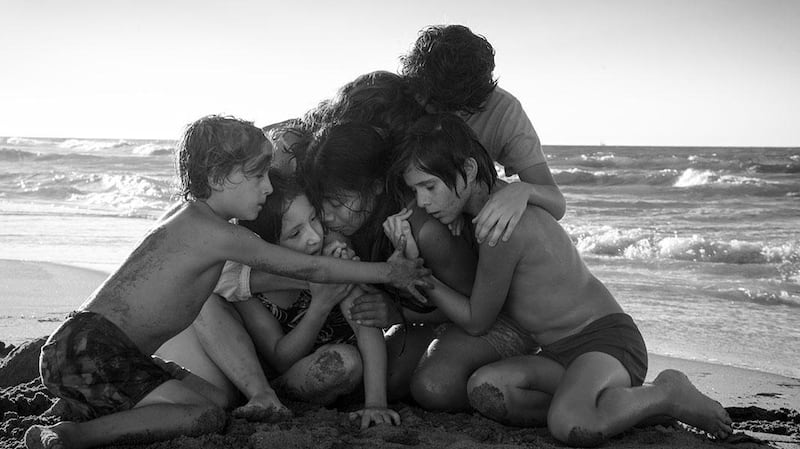If you’ve read anything about Alfonso Cuarón’s latest film you’ll have read something about its means of exhibition.
After a limited release in the United Kingdom, the film arrives here next week on Netflix and in Lighthouse (Dublin) and Palas (Galway).
There has already been some whinging about urban critics' potentially elitist demands to "see Roma in the cinema if you can". Fair point. Such statements can read like taunting to those not in the catchment area.
Let us just wearily note that there are majestic flourishes here that will be diminished when translated to the smaller screen (even those attached to none-more-elitist “home cinemas”).
Cuarón may be telling an intimate story – the doings of a mildly troubled middle-class family in 1970s Mexico City – but he is using the grandest imaginable cinematic language.
Shot in luminous black and white on 65mm, the picture abounds with hugely long master shots that sweep eye-poppingly across busy vistas; streets swelling with chatter and commerce; department stores throbbing to riots; the route from beach to toiling waves.
The sound design is more remarkable still. Eschewing any non-diegetic music, Cuarón employs the Dolby Atmos system to surround the viewer with chatter and noise. No superhero epic has been so immersive.

Why not? Alfonso Cuarón is working through themes of monumental import to Alfonso Cuarón: his own formative years in a changing society. More specifically, he is constructing a tribute to the indigenous Mesoamerican nanny who helped the family through a divorce and concomitant traumas.
There is the faintest hint of belated apology from Spoilt Bastard here (though the version of young Cuarón doesn't wear the Viz character's sailor suit).
Roma allows Cleo, a hard-working woman with a trusting personality, her own life and her own passions, but, played with great warmth by the excellent Yalitza Aparicio, she never feels at the centre of the story.
Everything is connected. Everything is bewitching. No corner of the frame has been left unattended
The film believes in the same benevolent domination we encountered in series such as Downton Abbey or Upstairs Downstairs. Cleo's employers think her "part of the family". She'll watch telly with them, but she is required to hop to it when somebody needs a biscuit.
The audio-visual sweep of Roma is so impressive that it's easy to ignore these underexplored socio-economic crosscurrents. There is not a lot of plot. Dr Antonio (Fernando Grediaga) and his flamboyant wife Sofía (Marina de Tavira) live in the eponymous suburb with their four bustling children.
Early on, father heads off to a conference and – while Sofía offers increasingly feeble excuses – repeatedly fails to return home. Meanwhile, the city bubbles with discontent and Cleo falls for a local boy who fancies himself as a martial artist.
Acting as his own cinematographer, Cuarón communicates his passionate nostalgia through bravura takes tied together by recurring visual refrains. The opening shot is a marvel in itself: as soapy water washes over tiles, it reflects an aeroplane leaving the city. We later learn that the plane is taking dad away and plunging the family into worrying uncertainties.
A significant scene for Cleo plays out in a cinema screening of the enormously successful (though largely unknown in Anglophone territories) French comedy La Grande Vadrouille. Everything is connected. Everything is bewitching. No corner of the frame has been left unattended.
If anything, the film slightly overdoes its virtuoso gestures. One occasionally longs for the ordinary consolations of unadorned conversation.
No fair-minded viewer would, however, argue that the technical élan overshadows emotion. Alongside fascinating social observations and surprising outbreaks of humour, Roma features one or two of the most heart-wrenching scenes in recent cinema.
See it via whatever medium you fancy.
Roma is playing in Light House, Dublin, and Pálás, Galway











